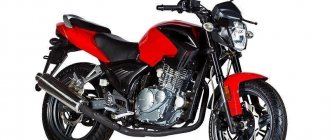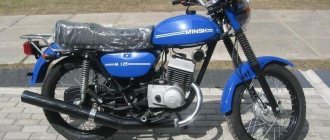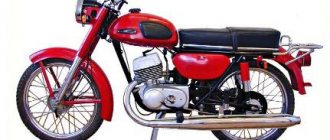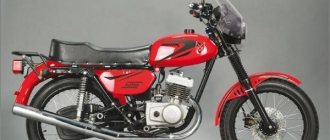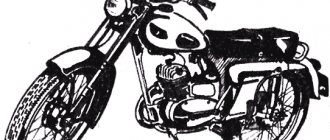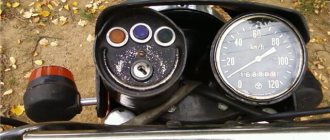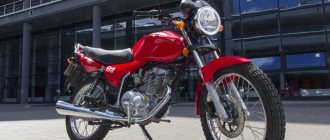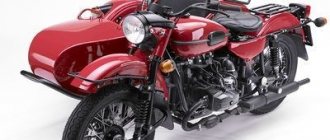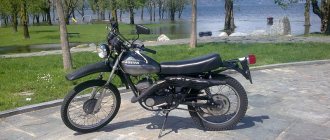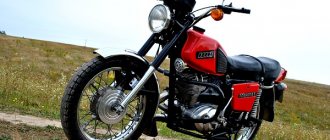Minsk Leader 125 has not gained noticeable popularity among buyers. This happened, most likely, due to the shortsightedness of the people responsible for monitoring the market and planning a trading strategy. Representing a slightly modified Minsk MMVZ-3.1131, Leader 125 already seemed quite outdated at the time of release. Meanwhile, a flood of used Japanese motorcycles poured into the country, and the Chinese were already eagerly rubbing their hands, preparing to flood Russian motorcycle showrooms with cheap equipment... So the outcome, alas, was predetermined from the very beginning. The technical characteristics of the Minsk Leader 125 were already frankly weak when these motorcycles went on sale, and the “greetings from the USSR” design could only appeal to retrogrades. However, all this does not make the bike bad - it was just late, and when it came to the market, it was surprised to find that it was unable to compete with the new competitors. As a result, the model, which was not in demand, was quickly discontinued.
MMVZ
Minsk motorcycles were rapidly gaining popularity both in the USSR and in foreign markets.
Their deliveries were made to 45 countries around the world, and the total number exceeded 6.5 million. From the first years, the brand took an active part in motorsports, mainly in cross-country and circuit racing. The first cross country “Minsk M-201K” and enduro “M-201M” were created in 1956. Three samples of the first highway-ring ShK-125 with a record 23-horsepower engine for that time were produced in 1961. A decade later, the first road racing motorcycle with a developed fairing, the M-211, appeared, followed by the MMVZ-3.216 (1977) and MMVZ-3.227 (1986).
Significant milestones in the history of Minsk motorcycles were the Minsk-Pamir (1969) and Brest-Vladivostok (1971) motorcycle races.
A new model designation system, developed by the VNII-Motoprom of the USSR, was introduced in 1973 on the new Minsk MMVZ-3.111, which received the USSR State Quality Mark:
MMVZ - manufacturing plant;
3 - motorcycle class (up to 125 cm3);
1 — type of motorcycle (road);
11 - serial model number.
The reliability and unpretentiousness of Minsk motorcycles have made the Minsk brand iconic in Vietnam, which has become the largest export market. Vietnamese motorcycle fan club Minsk since 1988. holds gatherings for fans of the brand, which annually attract more than a thousand people. On the set of the Top Gear Vietnam Special, the Minsk motorcycle was driven by Richard Hammond.
By the early 1990s, motorcycle production had increased to 220,000 units per year. In 1999, the Minsk brand received the Arch of Europe Award for its approval in the international market.
Similar models
- Minsk MMVZ-3.1131 (Minsk 125). It was he who served as the basis for the development of the new model, and the differences between them are minimal.
- Sunrise 3M. Especially the latest motorcycles in the series. You can find them on the secondary market for very modest money, but most copies are in poor condition.
- Owl . Having replaced the aforementioned Voskhod on the assembly line, this bike has deservedly gained popular love.
Spare parts and repairs
Of course, it is difficult to say that the new Minsk has inherited the reliability and unpretentiousness of its two-stroke ancestor, but it cannot be called bad either. The engine, although it is a Chinese design, works properly and, if used correctly, can demonstrate a good service life.
Minsk has long established itself as a national brand, and now it is trying to maintain its name.
Many consumables and spare parts can be easily found on the Internet at an affordable price. As for residents of the Republic of Belarus, there are purchasing options in MotoVelo stores.
The motorcycle has an extremely simple design, so almost any breakdown can be repaired in your own garage.
Technical characteristics of Minsk 125 Sport
Don't be fooled by the motorcycle's partial Chinese origin. Real professionals worked on it and were given the non-trivial task of designing a small-capacity sportbike that was both high-quality and inexpensive. It is not known what tricks they had to go to in order to ultimately demonstrate the Minsk 125 Sport motorcycle to the public, but the work was clearly not easy. Judge for yourself: a modern duplex frame, a swingarm with forged tips, disc brakes, chic design, a functional instrument panel, a peppy 1-cylinder engine producing 11 hp. and 9 Nm of torque. The only things that stand out from the overall picture are the 5-speed gearbox instead of the 6-speed and the carburetor instead of the injector.
They also worked hard on the ergonomics of the Minsk 125 Sport. The compact and lightweight (110 kg) motorcycle is comfortable for both tall and short bikers to sit on, and there are no problems with reaching the ground with your feet. If you wish, you can maintain an upright position, like on a classic bike, but you can also lie down on the tank to feel like a real racer. True, the gas tank only holds 7 liters of fuel, but this is quite enough considering the consumption of about 2.5-3 liters per 100 kilometers.
The suspensions are not adjustable, but they are good without it. The problem with many Chinese motorcycles is that they are designed to carry the weight of puny Chinese, but the Minsk 125 Sport was developed for the CIS market, and it copes with the load perfectly. The presence of a passenger, of course, affects the length of the braking distance, but in general the bike’s braking system is quite good, with discs on both wheels. However, I would like the rear brake to be more effective.
Specifications
The motorcycle is equipped with a single-cylinder two-stroke engine with a capacity of 125 cc. The cylinder is a cast iron sleeve pressed into aluminum fins. The head is also aluminum. This allows for efficient heat removal.
Previously, the site Ru-moto.com published a review of the Minsk D4 125 motorcycle
The engine did not have a separate lubrication system, so the oil had to be mixed directly with gasoline. The A-76 was suitable, with minor modifications it was possible to drive the A-92. The intake system is carried out by the good old carburetor. Power is 12 hp at 6300 rpm. The engine, despite its small volume, turned out to be durable and resourceful.
Equipped with a four-speed gearbox. Multi-disc clutch in oil bath. The drive to the wheel is carried out via a chain, which is protected by special casings without interaction with the external environment. This made it possible to operate the motorcycle on sandy roads without worrying about contamination of the chain and sprockets.
Motorcycle Minsk MMVZ-3.112
The motorcycle had a tubular frame. The suspension was a telescopic fork with hydraulic shock absorbers at the front. At the rear there is a pendulum and two shock absorbers.
Electrical equipment includes all necessary lighting devices and has 12V. One of the important features is the absence of a battery in the system, which adds simplicity and unpretentiousness to the design.
| Total information | |
| Dry weight | 104.5 kg |
| Maximum load | 150 kg |
| Maximum speed | 95 km/h |
| Fuel consumption | control at a speed of 71 km/h - 3.3 l/100 km, average operational - 4.0-4.5 l/100 km |
| Dimensions | |
| Length | 2100 mm |
| Width | 790 mm |
| Height | 1200 mm |
| Base | 1230-1320 mm |
| Ground clearance | 125 mm |
| Engine | |
| Number of cylinders | 1 |
| Number of cycles | 2 |
| Working volume | 123 cm3 |
| Compression ratio | 9,2—9,8 |
| Gasoline used | A-76 |
| Power | 12 hp at 6400—6600 rpm |
| Transmission | |
| Clutch | multi-disc in oil bath |
| Transmission | four-speed with foot shift |
| main gear | chain in a sealed casing |
| Tires | 3,00—18 |
| Crew part | |
| Frame | tubular single |
| Brakes | drums |
| Suspension | front wheel - spring telescopic fork with hydraulic shock absorbers; rear - pendulum spring fork with hydraulic shock absorbers |
Power point
The two-stroke engine of the Minsk motorcycle of the MMVZ-3.112 brand was unpretentious in maintenance and quite reliable.
- type - gasoline;
- number of cylinders - 1;
- piston stroke - 58 mm;
- cylinder diameter - 52 mm;
- working volume - 123.6 cubic cm;
- compression degree - 10.5;
- power supply: K-62S carburetor;
- cooling - air;
- fuel - A76 gasoline, mixed with oil in a ratio of 25: 1;
- maximum power - 12 hp. at 6900 rpm.
Disadvantages of Minsk 125 motorcycle engines
- Vibration during operation;
- Weak power;
- Slow acceleration;
- The need to prepare a fuel mixture of gasoline and oil, which is very inconvenient when traveling long distances. Not every gas station sells oil for MMVZ, so you have to carry it with you.
Conclusion. Simplicity of design, high reliability, optimal technical characteristics, along with efficiency and safety of operation, long-term maintainability (use of detailing with repair dimensions) made the engine, and with it the Minsk motorcycle, popular among the people. Very convenient for use on the farm, especially in rural areas for going out into nature for hunting, fishing, picking mushrooms and nuts. You can close your eyes to all the listed weaknesses and shortcomings; I say this from my own experience. All of the above breakdowns can be easily fixed with your own hands. There are no problems with the availability of spare parts for sale. It couldn’t be easier to overhaul an engine with your own hands, except that you may need the help of a turner to bore the cylinder to the repair size, followed by honing, if the diameter taper along the cylinder liner mirror exceeds 0.06 - 0.08 mm. Reliability rating is “good”.
PS Dear “Minsk drivers”! I look forward to your feedback and comments on the shortcomings and weak points of the 125 cm³ MMVZ engine.
Repair dimensions of piston pin MMVZ Minsk 125 cm3
| Piston pin | Piston (pin hole) | |||
| Color group | size, mm | Color group | size, mm | |
| ∅ 14 -0,0075 | ∅ 14 (+0,005-0,010) | |||
| white | 14,0000 — 13,9975 | white | 14,0050 — 14,0025 | |
| white and blue | 14.0025 — 14,0000 | |||
| black | 13,9975 -13,9950 | black | 14,0000 — 13,9975 | |
| black and blue | 13,9975 — 13,9950 | |||
| red | 13,9950 — 13,9925 | red | 13.9950 — 13,9925 | |
| Red and blue | 13,9925 — 13,9900 | |||
| It is allowed to install pins and pistons in the following configurations: | ||||
| finger | piston (pin hole) | |||
| white | white, white and blue, black | |||
| black | white and blue, black, black and blue, red | |||
| red | black and blue, red, red and blue | |||
Select the desired product option
| Image | Name | Present | Price | Availability |
| Minsk D4 50 (50 cc) | RUB 1,890 | Not available | ||
| Minsk D4 70 (70 cc) | 2,000 rub. | In stock | ||
| Minsk D4 110 (110 cc) | RUB 2,260 | Not available |
The universal moped Minsk D4 50 is an excellent option for those who are not quite ready for a powerful motorcycle, but no longer want to pedal a bicycle. A small-capacity vehicle is ideal for beginners so that they can get used to two wheels with an engine, and then switch to something cooler. Such mopeds are also popular among hunting and fishing enthusiasts, as well as among adults who need to get to their dacha or village.
Advantages and disadvantages
Advantages
- Modest mass. The weight of the Minsk 125 motorcycle allows even short and not very physically strong bikers to move the bike with ease.
- Dynamics. Of course, it’s not worth comparing the Minsk 125 with modern motorcycles; after all, they are separated by entire decades. However, it accelerates quite briskly, and the maximum speed in Minsk reaches 95 km/h.
- Simplicity of design. Repairing this bike is not easy, but very simple.
- Availability of spare parts. Even today, there are usually no problems finding them.
Flaws
- 2-stroke engine. When you fill the tank with gasoline at a gas station, you need to add engine oil. In addition, the resource of 2-stroke engines is short.
- Minsk 125 technical characteristics do not really correspond to modern standards. Bikers accustomed to other motorcycles will probably find it boring, unless they are fans of retro technology.
Advantages and disadvantages
The model has a lot of advantages, so it’s worth listing the main ones:
- Low price (up to 45 thousand rubles depending on mileage and region of sale);
- Good dynamic performance, among which it is worth noting power and maneuverability;
- Stylish appearance, as well as the absence of the impression of a “budget” motorcycle;
- Low fuel consumption with a large tank;
- Comfortable fit;
- Anti-slip seats;
- Reliability of assembly;
- Possibility of purchasing parts in almost all stores.
The model also has disadvantages, namely:
- Passenger footrests welded to the swingarm;
- Fuel sensor readings are inaccurate;
- Lack of tachometer;
- Poor place to store a set of tools;
- On some individual motorcycles, the odometer does not work (the reason is poor quality assembly);
- Sometimes minor problems with the carburetor are detected.
In conclusion, it is worth saying that repairs and tuning of the D4 125 model will cost the owners inexpensively, which is also an advantage of the motorcycle.
Price
The Minsk motorcycle, the price of which was always kept at a budget level, was accessible to all segments of the population of the former USSR. In some regions it was used as an incentive prize for particularly distinguished employees, machine operators, farmers, and shock workers of communist labor.
Currently, the Minsk motorcycle, the price of which varies from 65 to 145 thousand rubles, can be purchased at the car market. Before purchasing, it would be a good idea to evaluate the technical condition of the car from an expert point of view for further restoration. If a motorcycle is purchased for the purpose of operation, then it will necessarily require repairs, routine or major. Therefore, the future owner must make sure that the necessary spare parts can be freely purchased at retail.
The lineup
At the moment, three main models are produced, as well as a redesigned Minsk motorcycle in the old design. Here is the current model range:
- Model C125;
- Model D4 125;
- Model M125.
Also, as already mentioned, a fairly old model MMVZ-3.1131 is produced, now it is called Leader. This motorcycle managed to retain all the main features of the original model; especially fans of Soviet motorcycles like the design, which, if possible, has not been changed. Also, Minsk tuning is often carried out with this option.
Model C125
This option is considered basic, so it makes sense to start a review of the Minsk motorcycle with it. This modification was created for any type of road. Also, the technical characteristics of the Minsk motorcycle of all modifications are based on this bike.
This model can be used even off-road; for this purpose, high-quality tires with a high tread are installed. But such a modification somewhat limits the speed on the highway; vibration is felt when driving over 60 km/h.
A two-stroke engine has one cylinder. This is quite enough for optimal operation. Consumption per 100 km when driving on a highway does not exceed 3 liters; on a country road this figure approaches 4 liters. The engine is started using a kick starter.
This method allowed us to achieve maximum reliability in any conditions. The weight of the motorcycle does not exceed 120 kg. The small size, as well as the presence of a two-stroke engine, leads to the fact that this technique is often used for a moped.
Model D4 125
This modification also has a single-cylinder engine, but here it is four-stroke. In essence, this is a sports motorcycle, the high number of revolutions allows you to maintain high speeds for a long time.
The power allows the motorcycle to accelerate to 100 km/h. The presence of 5 gears in the box makes the bike quite responsive and capable of rapid acceleration. Fuel consumption here does not exceed 2.6 liters per 100 km on the highway. There is an electric starter.
The net weight of the model is 100 kg. Some disadvantages, according to many, are the welded passenger footrests. Even if they are not needed, you will not be able to remove them. But this characteristic does not reduce the popularity of this modification.
Model M125
Of course, a review of the Minsk motorcycle could not do without mentioning the most popular model. It is Minsk 125 that is the most popular modification. It is very unpretentious, can withstand any road very well, and we can say about this motorcycle that it is indestructible.
Also, repairing it in practice turns out to be a fairly simple task. Even compression, which can vary on other engines in the series, does not create problems here. The engine here is single-cylinder, two-stroke. Reviews say that there are no problems with it. It consumes the bare minimum of fuel, about 2.5 liters on the highway.
The basic version is offered with drum brakes, but if desired, you can order a modification with a disc brake. You can also purchase a Minsk motorcycle with a sidecar, this will allow you to transport additional loads on it. The weight of this model is 120 kg.
Minsk Leader
This modification almost completely replicates MMVZ-3.1131. There are some changes, but overall the descriptions are the same. It is worth noting that, unlike the base model, there is a slightly larger engine capacity, which makes the motorcycle more playful. Otherwise, it completely repeats the legendary Soviet model.
When deciding whether to buy this variety, you should take into account that the shock absorbers are not very good, which reduces the level of comfort.
Previous entry Installing one carburetor on a Ural motorcycle Next entry Motorcycle tuning Minsk - instructions for modernization
Motorcycles of the Belarusian brand Minsk
At one time, the motorcycles of the Minsk holding stood out from the rest due to the high quality of components and the ability to travel in almost any conditions. Years after the release of the first model, the Minsk-based company still produces high-quality motorcycles, scooters, ATVs and snowmobiles.
History of creation and international success
Motorcycles from the Minsk company appeared on the market back in 1951. Over its 70-year history, the manufacturer has sold more than 7 million motorcycles in more than 50 countries.
The basic model is the M1A motorcycle. Modifications of this model have become widely known due to their versatility - the vehicle is suitable for both simple road driving and off-road use with an installed Enduro power unit.
After World War II, German in the USSR, or more precisely in Moscow. There the plant began producing the first motorcycle models under the M1A brand. In 1951, the production of this brand of motorcycle was transferred to the Minsk Motorcycle Plant.
A large number of Minsk motor vehicles were sent to Vietnam and other Asian countries. This was facilitated by the high quality of components, powerful technical performance and affordable price. Such success led to a worldwide calling, and engineers had to modify their own line. In Vietnam, they even organized a fan club for motorcycles, Minsk, which officially opened in 1988. It is noteworthy that the club annually celebrates motorcycle day, attracting an increasing number of members and fans of this equipment.
In 1991, the Minsk motorcycle received an update that brought its technical performance to almost its maximum. That year, the number of products produced reached 225 thousand every year.
In 1999, the vehicle received the prestigious international “European Arc” award, which once again emphasizes the value of the motorcycle outside the countries of the former Soviet Union. After that, the award-winning model was modified several times, which increased the demand for it in Europe.
Specifications
Technical indicators should be divided into two categories: external and internal.
External characteristics
The length of the motorcycle is 2.1 meters. The height is 1.2 meters with a distance between the axes of 1.32 meters. The size of the rudder line is 0.8 meters. The ground clearance is 12.5 cm.
The Minsk motorcycle reaches a maximum speed of 95 km per hour with a maximum permissible passenger weight of 165 kg.
Internal characteristics
The power unit of the Minsk motorcycle has always been unpretentious in operation, remaining extremely reliable even by modern standards.
The motorcycle engine is gasoline-based, with one cylinder, the diameter of which is 0.52 cm. The piston stroke is 0.58 cm with an engine displacement of 125 cc. see. Maximum engine power is 12 horsepower at 6.9 thousand rpm.
The motorcycle has always been distinguished by high-quality compression, the degree of which is 10.5. The motorcycle is powered by a K-62C carburetor with an air cooling system.
The motorcycle has a four-speed gearbox with a foot shift mechanism.
It is recommended to use 76 grade gasoline as fuel in a proportional ratio of 25 to 1 with engine oil. Fuel consumption averages 3.5 liters per 100 km.
The lineup
Now the plant in Minsk specializes in the production of three types of motorcycles:
- classic – C 125, C4 125, C4 200, D4 125, M 125 and M 125X;
- enduro (for off-road driving) – TRX 300i, X 200, ERX 250;
- street (sports motorcycle for city driving) – R 250, C4 250, CX 200.
At the moment, the most affordable and popular are the following Minsk motorcycle models:
All of these models have an engine capacity of 125 cubic centimeters to achieve the maximum balance of performance and efficiency.
Minsk S 125
This model is considered basic. The motorcycle is considered an SUV, so most Minsk motorcycles are produced on its basis. For off-road driving, the motorcycle is equipped with high-strength rubber, with which the warrior can reach speeds of up to 60 km per hour.
Engine with two strokes and one cylinder. This power unit is enough for a comfortable ride. Over 100 kilometers traveled, the motorcycle will “eat” 3 liters of gasoline. When traveling over rough terrain, this figure will increase to 4 liters.
The engine is started using a kickstarter. This system provides reliability in all weather conditions.
Many users mistake the C 125 for a moped. This is facilitated by its small dimensions and two-stroke engine.
Watch a video review of the Minsk S 125 motorcycle:
Minsk D4 125
The power unit is also with one cylinder, but with four strokes. The model belongs to the sports category. The number of revolutions that the motorcycle produces allows you to maintain high speed driving for a long period of time.
The maximum speed is 100 km per hour. For quick acceleration, a gearbox with five gears is installed. Gasoline consumption per 100 km of driving will be only 2.6 liters. A big plus is the presence of an electric starter.
The vehicle weight is 100 kg. Many drivers consider the presence of a welded footrest for passengers to be a disadvantage, because it cannot be removed.
Watch a video review of the Minsk D4 125 motorcycle:
Minsk M 125
M 125 is the most popular model in the company's line of motorcycles. This success is based on low maintenance. Many users say that the M 125 is simply impossible to kill.
The motorcycle has a single cylinder, two stroke engine. Fuel consumption is also minimal: over 100 kilometers traveled, the gas tank will be empty by 2.5 liters.
The standard version is equipped with drum brakes, which can be replaced with disc brakes. As an additional option, you can order a stroller for carrying cargo. Model weight – 122 kg.
Watch a video review of the Minsk M 125 motorcycle:
Price
Minsk motorcycles have always been available at an average price. At the moment, the average cost of a motorcycle is 75 thousand rubles, but modified versions can cost 150 thousand rubles.
Almost 70 years after the launch of production of the first motorcycles, the Minsk company continues to remain among the leaders in manufacturers of high-quality and inexpensive motorcycle equipment. At the moment, Minsk brand motorcycles are produced in three modifications.
Motorcycles Minsk and motocross
In addition to road-class models and motorcycles for road racing, the Minsk Plant produced several models for cross-country racing. The first model was MMVZ-3.221. This is the first full-fledged motocross motorcycle from Belarusian manufacturers.
It’s worth telling more about this motorcycle. After all, a whole era began with him, a new generation of cross-country motorcycles Minsk. Among all the other cars in the plant's lineup, this one was special. She may not have received the “quality mark,” but she fully deserves it.
This interesting Minsk motorcycle, the technical characteristics of which we are going to tell you, appeared in the 80s of the last century. Many samples of this model are still in working condition, which indicates the high quality and reliability of the equipment.
Considering that the production of this popular model ended almost 20 years ago, spare parts for the Minsk MMVZ-3.221 motorcycle can be very difficult to obtain. For example, an engine for a cross-country version is very rare. Therefore, it is easier to purchase a version for the road and bring it to life with your own hands.
The cross-country model can hardly be called a high-speed one. On average, it reaches a speed of 40-50 km/h, and the road version is slightly faster – up to 65.
Initially, the engine of the Minsk motorcycle was “tailored” to 76 grade gasoline. After a little modification it easily transfers to 92nd.
The brakes are drum brakes and are quite good. The suspension is quite soft and copes well with uneven surfaces. In general, the machine can be adapted for universal purposes. She drives around the city very well.
You may also be interested in: Honda motorcycles: the history of a great company
In general, over the years of MMVZ's existence, 14 serial models of sports motorcycles were produced, a third of which were intended for motocross. Minsk sports motorcycles, new and used, are valued among professionals.
Reviews from owners of Minsk Leader 125
A completely indestructible jalopy, it was purchased back in 2003 second-hand for a couple of thousand rubles, I don’t remember exactly, it’s still alive, it’s used for driving around the area in the country. It breaks all the time, can be repaired with a kick or a blow with a sledgehammer, there are spare parts on the market, they are sold almost by weight. The most expensive part that I have changed so far is the carburetor, I installed some Chinese one, I tinkered with it - it works. If only there were spare parts, I think Minsk would even survive the Third World War)) Sergey, Moscow, Minsk Lider 125 '1999.
My first mot, I still remember sometimes. True, mostly with a feeling of relief that I will never see this fiend of hell again. Ironically, now I’m driving a new 250 cc Minsk, heaven and earth in general, and the old one has long been in the trash heap, where it belongs. Ilya, Saratov, Minsk Leader 125 '2003.
A real Soviet legend in a new wrapper, in fact - an ordinary old Minsk with some other little things like a separate lubrication system, a different exhaust and side plastic. If the arms grow from the right place, the motorcycle is practically eternal. You just need to fill it with normal oil, and not M8B, which a normal person would disdain to lubricate door hinges and service it on time. Modern Chinese are no match for old motorcycles, they are all disposable, but the old Minsk is still in perfect order. Anatoly, Ust-Ilimsk, Minsk 125 Lider '2000.
Sports motorcycles Minsk
Over the long years of its history, the plant has produced many interesting models of not only road, but also sports motorcycles of various classes.
After the company became private in 2007, active development of enduro, cross-country and sports motorcycles began.
The first sports motorcycle appeared in 1956. For that time it had advanced technology. And although, in many respects, borrowings from German technology were still preserved, the designers of the Minsk plant seriously modernized it. Changes affected the suspension, frame and other components. The model was called Minsk M-201K.
Nowadays sports and off-road motorcycle models are also produced. An interesting example is the M1NSK RX 450 cross-country motorcycle. The engine here is a single-cylinder, four-stroke, with a volume of 450 cubic meters. Liquid cooling, power 54 hp. Tank volume – 11.5 l. The gearbox is 6-speed. Disc brakes. Weight – 110 kg.
Minsk, a motorcycle manufactured in 2013-2014 costs an average of 125 thousand rubles.
Of the off-road motorcycles, the following models are worth noting:
- M1NSK X 200;
- M1NSK ERX 250;
- M1NSK TRX 300i.
X 200 is a classic enduro, designed for both regular roads and rough terrain. There is a 200cc engine with a power of 15 hp at 7500 rpm. Air cooling. With a “dry” weight of 128 kg, this machine can reach speeds of up to 110 km/h.
The model appeared on the Belarusian market in 2010. And over the 4 years that the motorcycle has been on sale, it has not only become popular in the country, but has also been actively exported to many countries.
These are fairly affordable new Minsk motorcycles whose prices suit most potential buyers. To save money, some people buy them with low mileage.
It will also be interesting: Ural motorcycles and the fate of the Irbit plant
The 200 can be praised, but it can also be criticized. Especially in the latter, motorcyclists distinguished themselves, considering the production of Chinese motorcycles under the Belarusian brand unacceptable.
And they say this for a reason. In fact, the X200 is a redesign of the Loncin JL 200 GY-2C l (aka Zongshen LZX200 GY-2). Experts recommend immediately changing the air filter, chain and pendulum, and installing crankcase protection. If you like this Minsk motorcycle, you can buy a new one in excellent condition, with all documents, for about 2-3 thousand US dollars.
At first glance at the M1nsk r250 model, it’s hard to believe that this beauty was produced in Belarus. This is not surprising, because the author of the project belongs to the Megelli company. In Minsk it is produced “as is”, without simplifications and cheap spare parts.
The engine capacity of this motorcycle is 249 cm3. Power – 26 “horses” at 8500 rpm. Speed 145 km/h. Water cooling.
This modern and high-tech motorcycle Minsk price is 45 million Belarusian rubles (approximately 4500 US dollars).
Will we love “octams”? We choose motorcycles up to 125 cm³
Subcategory of rights A1, which includes motorcycles with a displacement of up to 125 cm³ and a power of up to 11 kW (14.9 hp), is a resolved issue for Russia. So, we have reached the level of civilized countries, but should we be happy or sad about this? Previously, the “one hundred and twenty-five” niche was not particularly popular in our country and there was little technology. What awaits the market in 2012?
000_moto_0312_036
All motorcycles imported into Russia can be roughly divided into two categories: . However, this division is very arbitrary: even well-known models are “yellowish,” if not entirely made in China, Taiwan, or even Turkey, Indonesia and Vietnam. It is significant that famous brands usually have one or two “125” class models in their lineup. After all, this equipment is, as a rule, a training desk, which cannot be bypassed by law. And there will always be a demand for it, until the craving for motorcycling fades or the last drop of gasoline is burned. Only companies with image bikes (such as Harley, Victory or Ducati) do not condescend to unpretentious “sufferers”. But there are progress here too, an example of this is KTM (we’ll talk about it separately).
IT'S NOW CHEAPER
The “under 50” group (we are talking about thousands of rubles) is opened by two twins: Lifan LF125–5 and Patron Simpler 125, clones of the Honda CG125 model of 1976. Their appearance is archaic. A very common engine in China with a characteristic lower camshaft (OHV design) is installed in an open steel frame. This shaft has only one cam, which, through two pairs of rocker arms and a rod, controls two valves in the head. The engine turned out to be compact, lightweight, reliable, there are no problems with spare parts or repairs. And the devices themselves are extremely simple: drum brakes, primitive spring suspensions, passenger footrests are attached to a pendulum made of a thin round pipe, which does not pretend to be rigid. Fans of the style of the late 1970s, and indeed old hardware in general, will appreciate the shape of the tank, stylish markings, 18-inch spoked wheels, fenders and seat base made of natural steel. There is a lot of chrome, a strong trunk, a tachometer and an electric starter. On the training “figure”, the motorcycles are simply super: light as a bicycle, the angle of rotation allows you to pass the figures with a margin, and neutral is easily caught. Brakes on the training ground are not particularly needed, it is even valuable when they are weak, so as not to accidentally block the wheel and trip. But on the road you feel uncomfortable with these, especially in the city.
A little further from the border of primitivism is the Patron Aero 125F. It is equipped with the same “tsegesh” four-stroke “air vent”, but with glimpses of modern design. There are cast five-spoke wheels, more advanced suspensions and a sporty-looking muffler a la Akrapovich. The view is no worse than that of its Yamaha classmate (we’ll get to that later), but the price of the Aero is almost half as much.
Not far from this technology are the Minskis, of which there is a whole range on our market. Actually, the “125” cubic capacity has become the crowning glory for Belarusian cars since 1951, when they began producing a copy of the German DKW RT125. The descendant with a two-stroke engine is today called Minsk M125. The motorcycle does not have a separate lubrication system and an electric starter (there is no battery either), with a four-speed gearbox. Spoke 18-inch wheels - with drum brakes (there may be a disc at the front, but you need to look for such equipment), a durable closed-type frame is used, a sealed chain casing, suspension - with “hydraulics”. Minsk M125X with the self-explanatory name “Forester” is equipped with a durable three-sided trunk, headlight protection combined with a small trunk and an “upper” plastic wing.
But the Minsk C4 125 with a 4T engine is priced out of our group, but it is logical to consider it along with the others. After all, in fact, it eliminates all the shortcomings of simple Minsks: it has an electric starter, a front disc drive and a five-speed transmission. True, I had to sacrifice the chain casing. Although Minsk is cast on the cover of the unit, it is produced by the famous Chinese company Zongshen. This is not a clone of a Honda engine, but a Yamaha one, in which the camshaft is located in the head (ONS diagram). This classic-looking device is very good for both beginners and rural residents, many of whom still have Soviet two-stroke bikes from Minsk in service.
PRETEND TO BE A MOPED?
Although devices in the guise of a classic scooter are popular in Europe and are even updated by such giants as Honda, Yamaha, Suzuki, they are not brought to us - they are not prestigious and expensive. And most importantly, the small demand is fully satisfied by the Chinese motorcycle industry: cheap and cheerful. Although you rarely see the “125” cubic capacity, these are usually engines of 90–110 cm³. Examples on our market are Irbis Irokez 125, Patron Ringer 110. Like all scooters, they are attracted by improved protection from wind and water, plus a semi-automatic transmission. That is, you still need to change gears, but you don’t have to think about the clutch and the possibility of stalling. What is especially valuable is that you can pass the traffic police exam on a scooter. In addition, these devices are extremely light, and large 17-inch wheels and a sufficient turning angle facilitate the passage of the “figurine”. And in city traffic you feel like a fish in water (the author knows this firsthand - he himself has covered 20 thousand km, mostly in the metropolis).
The 125 cc Orion 125/B motorcycle fits very well into a moped. It has small dimensions, thin wheels and an archaic appearance; traffic cops don’t even look in the direction of such “self-running bicycles”. However, the motorcycle features are obvious - the layout (tank between the knees) and the “manual” clutch of the “Kab” engine. A plus in relation to scooters is a fairly capacious tank (8.5 liters compared to 3.5 liters), and that’s probably all. There are no suspensions, the brakes are weak, the electrics are assembled somehow. The only good thing is the price, provided that the buyer’s hands grow from where they need to be...
The Sachs MadAss 125 is a completely different matter - a “Chinese” under a glorious German brand, it is not the first year on our market. The ascetic “naked” appearance and original design justify the name “Raging Ass”. The device, weighing only 95 kg, is designed for two, although without any special amenities. There is no smell of archaic or classic here - MadAss is equipped with “tenacious” disc brakes on both three-spoke wheels and two powerful lens headlights. In addition to its exterior, the motorcycle differs from scooters in its “manual” clutch and 16-inch wheels; in the cooling system there is an oil radiator. In city traffic it is nimble and agile, but for long journeys you will need a really mad ass...
The Celestial company with the star brand Sky Team is known for clones of Honda “Cab” “babies” such as Monkey, Dax and Gorilla. They are offered in the form of both “fifty dollars” and almost indistinguishable in appearance, but with the cubic capacity of motorcycles. These are Skymax (ST125–6A) and Gorilla (ST125–8A). Their advantages are high similarity to the original and compactness. However, the appearance of the bestsellers of past years in Europe does not awaken any feelings in the Russian buyer. And the compactness is good for storage and transportation (these models even enter the elevator with a whistle), but on the road there is a big drawback: a person on such a motorcycle is not visible in traffic. Therefore, I will not recommend that adults (and even more so teenagers) ride them around the city - it’s simply dangerous.
New this year is the KYMCO K-Pipe 125. The device has a motorcycle layout, however, like scooters, there is no “manual” clutch. Beginners will like the light weight and inability to stall, as well as the cool appearance. The production of K-Pipe is scheduled to begin in Kuoshung (where KIMCO's head plant is located) in March 2012, and it is expected to go on sale in mid-summer.
TIMELESS CLASSICS
The Taiwanese SYM XS 125 is, in fact, a variation on the theme of Yamaha’s “Yubi-era”, only not what is offered in Russia, but the European one (more on that a little later). The frame is connected through the power unit, but the latter is not a clone of the mentioned Honda CG series, but almost identical to Yamaha. The device is so canonical that there is nothing special to write about: disc-drum brakes, 18-inch wheels, five gears. Convenient for beginners, practical, with an ageless appearance. And at the same time with a completely humane price.
The Yamaha YBR125, perhaps the most popular in Russia among beginners, owes its success primarily to the brand. There is no shame in riding a motorcycle with an emblem in the form of three tuning forks. And few people care (and most don’t even know) that cars from Turkey are imported into Russia, in which the fuel injection declared on European websites is replaced by a carburetor, and the classic round headlight is rectangular with a shield of an incomprehensible shape. The price, compared to the almost identical SIM, seems overpriced. However, this does not detract from its riding qualities, and the motorcycle has deservedly become a training desk in most motorcycle schools.
Although the Chinese motorcycle industry is young, it seems that it is already ripe for the release of stylizations of the classics. Here, for example, is a new product for 2012 on our market - the BM Maxmen 125 model from the Kaliningrad Baltmotors, assembled at the large Chinese company Qingqi. The style of the motorcycle clearly gravitates towards the scramblers of the late 1960s; usually such nostalgic tricks are allowed by the masters of motorcycle construction, and then only in limited editions. And here you have style and an affordable price. And Chinci is not a bad company, it’s not for nothing that Peugeot is “friends” with it. They say that at one time the director there was sentenced to death for poor quality, after which things got better...
HOW BIG
The German-Chinese Sachs Roadster 125 is practically indistinguishable from the “bi-em” described above, and there are suspicions that they are birds of a feather. If there was a “Find Five Differences” competition, I would name the color of the engine, the lack of a lower fairing on the Saxon, the color of the plastic “flashing lights” - and that’s it. No, there’s also the price: the Russian “Chinese” one is significantly lower than the German one.
Small-capacity KYMCO Quannon EU3 - with sportbike features. Its 125 cc air-oil-cooled engine received a fuel injection system, which allowed it to comply with Euro-3 environmental requirements. The rear suspension has a monoshock absorber and 17-inch cast wheels. By the way, the Chinese meticulously tore up this model, and they installed more “cubic” engines of 150 and 200 cm³ (Sagitta Spitzer 150, Patron Sport 200, Stels SB200) into the clones. This partly equalizes the characteristics - where the “Kimkovites”, due to injection, a four-valve head and a more advanced 125 cm³ air-oil engine, “remove” 13 “horses”, the devices from the Middle Kingdom get, at best, the same amount, but with 200 “cubes”. True, the twofold difference in price should not be discounted...
Well, the fact that the “Quannons” run at 130 km/h (this is stated on the forums) is quite understandable wishful thinking, plus the effect of a tailwind on the descent. Still, with a power of 13 horsepower, you can’t fool physics, and although the bike has a semi-fairing, the landing is still quite vertical. However, the latter is not so bad: it is more convenient to ride a motorcycle in the city and improve basic skills. I wanted to say: learning - no, motorcycles in the “cheaper than ever” or “timeless classic” categories are better suited for learning. Rearward footpegs, a narrow handlebar with the handles pulled back and down, and a small turning angle are not at all what a training motorcycle needs.
The “octagons” of the Czech company Jawa Moto spol stand apart. sro This name still evokes strong nostalgic emotions among compatriots - the plant, which is more than 80 years old, at one time supplied over 2 million motorcycles to the USSR. The family of “125” class machines began to be produced a long time ago - in 1998, using 4T engines from the Taiwanese company CPI. At first these were clones of Honda’s CG series, later - more modern NX OHC circuits with quite high power for an “air blower” (12.8 hp). The frame is closed through the engine crankcase, the rear suspension is with a monoshock absorber, both wheels are equipped with disc brakes. The Dakar model is unique for our market in that it is a dual-purpose motorcycle, which is emphasized by the “chubby” 16-inch rear wheel, high front fender and handlebar guards. Unfortunately, there are no others like it: the good RT125D SUV from Hyosung almost didn’t survive in our market until the introduction of the A1. A more “parquet” modification is the Dandy, with a low front fender and 17-inch wheels with “quiet” tires. The maximum speed of both motorcycles is 110 km/h. Unfortunately, the price of devices from the Czech Republic is also unique, confirming the thesis that everything touched by a European hand becomes noticeably more expensive than products from the Celestial motorcycle industry...
SMALL CUMBER HI-TECH
One of these devices is the light sports bike Aprilia RS4 125. Last year it replaced the famous “two-stroke” RS 125. Naturally, this is a completely different device with completely different technical characteristics. The design and color of the “octagon” are borrowed from the company’s large-capacity sportbikes, which earn victories for the Italian brand on the race tracks. The new four-stroke engine has everything “grown up”: liquid cooling, a head with four valves, electronically controlled injection, a dry sump lubrication system, a six-speed gearbox. The motor meets strict environmental requirements. Matching the engine and chassis is an aluminum die-cast frame, an inverted fork with support pipes with a diameter of 41 mm. The passenger seat can be quickly removed and the motorcycle can be converted into a single seater. By the way, this particular motorcycle breaks all records for the cost of 125 cc machines in our market.
And another European company - KTM (Austrian, but a significant part of the shares belongs to the Indian company Bajaj) last year prepared an “entry class” naked bike 125 Duke. “Osmushka” is clearly aimed at young people, but it looks very mature and of high quality. It is equipped with a liquid-cooled DOHC engine with fuel injection. Its power is just under the “bar” of the limitation - 15 hp. at 9500 rpm. The chassis has not been forgotten either: the frame and pendulum are made of aluminum alloy, and the brakes use radial calipers. The fork is a “shifter” from WP with supporting pipes with a diameter of 43 mm. The rear tire has a class-record width of 150 mm. Along with the motorcycle, you will be able to purchase a lot of tuning components, such as petal brake discs, body kit elements, etc. They say there will also be a “cheating” switch that will allow you to squeeze all the juice out of the engine... as well as from the owner’s wallet. However, if you don't like the latter, take a look at the bikes at the beginning of this review...
Weaknesses of Minsk 125 motorcycle engines
- Transmission;
- Kickstarter;
- Carburetor;
- Exhaust pipe mounting;
- Control drive cables (clutch, gas).
The gearbox is one of the few weak points of the engine; problems with speed slippage during the operation of the motorcycle are not uncommon.
The kickstarter (the lever for starting the internal combustion engine with your foot) becomes loose over time at the point where it is attached to the engine starting shaft.
Due to the loss of mechanical properties of rubber parts and wear of the shut-off valve needle, the carburetor loses its tightness and gasoline leaks from it. Of all the carburetors installed at the factory, the Indian P-47R carburetors are considered the most reliable.
The attachment of the exhaust pipe to the cylinder is made in the form of a nut that presses the pipe to the cylinder, which is unscrewed due to vibration.
The cables of the control drives (clutch, gas) must be replaced periodically due to wear or breakage of the cable cable.
Advantages and disadvantages
It must be admitted that Chinese designers tried to improve the motorcycle as much as possible, while keeping its price at a low level. And they succeeded! So the bike has acquired not only, for example, good suspensions, but also such optional nice little things as a USB charger for the phone. And given its price, it would be unfair to judge it too harshly.
Advantages
- Light weight and ergonomics thought out to the smallest detail. The bike is easy and convenient to handle.
- Good suspensions for such a budget enduro.
- Ease of maintenance and repair.
- A good LED headlight with a properly concentrated light output.
- Energy-intensive long-travel suspensions that cope well with road irregularities.
Flaws
- Standard tires are of low quality. If your budget allows, it is better to replace it immediately after purchasing a motorcycle.
- At high speeds the engine generates strong vibrations.
- High fuel consumption when driving over rough terrain.
Repair and tuning
Maintainability, low cost of spare parts and a large amount of universal tuning at an affordable price are one of the advantages of Chinese motorcycles. Minsk x 250 is no exception in this matter, despite its Belarusian roots. After all, it is produced in the PRC, and in the fraternal republic they simply screw wheels onto ready-made copies, put a couple of stickers on them and send them to dealer showrooms.
Repair
It is easy to independently maintain and, if necessary, repair the bike. Its design is simple and logical, and any motorcyclist who is not afraid to get their hands dirty can figure it out. But if you were afraid of getting them dirty, you probably wouldn't buy an enduro, right? And for any operations with this motorcycle, a regular set of tools, a garage and, optionally, a couple of friends for company will be enough.
Spare parts
The Minsk x250 is currently being produced, and it is also assembled in Belarus, so there are no problems with spare parts. Dealers usually keep only consumables and the most popular parts in stock, but everything else can be ordered to order in a short time. Many units are suitable from other Chinese enduros, but they need to be selected by trial and error.
Total
The M1nsk company took the right path, using the name of a well-known brand and seriously concerned about quality control. Despite its Chinese origin, the Minsk D4 125 motorcycle is really reliable in operation, and with proper care there are no problems with it. It is also not difficult to find spare parts and consumables for it, since the manufacturer actively supports all produced motorcycles. So if you are looking for your first motorcycle, budget and simple in design, the Minsk D4 125 is worth taking a closer look at. This is not to say that it is better than all other 125 cc competitors, but it is better than many, that’s for sure, and reviews about it are mostly positive.
Modifications
The range of road motorcycles "Minsk" includes 17 different versions:
- the pioneer among all is, of course, the M1A-Moscow, manufactured in 1951;
- "M1M" was produced from 1956 to 1961;
- "M-103" was produced from 1962 to 1964;
- “M-104” - the model was in production from 1964 to 1967;
- "M-105" - (1967 - 1971);
- "M-106" was produced from 1971 to 1973;
- "MMVZ-3.111" was produced in the period 1973 - 1976;
- “3.115” - years of production 1976 - 1980;
- "3.112" was produced from 1982 to 1995.
In subsequent years, modifications were produced: “MINSK - D4-125”, “CX-200”, “R-250”, “C4-250”, “C4-200”, “M-125”, “M-125X”, "S4-125", "S-125".
Three enduro class models were also created:
- MINSK X200;
- MINSK ERX-250;
- MINSK TRX-300i.
A separate list includes sports modifications:
- models “M-201K” and “M-201M”, released in 1956 and intended for multi-day competitions;
- "Minsk ShK-125" - road-circuit racing;
- "M-213" (1969) - multi-day competition;
- MINSK RX 450, MINSK RX 250, MMVZ-3.221, 3.225, MMVZ-3.229 - motocross;
- "3.227" was produced between 1987 and 1991 for circuit racing;
- model "MMVZ-3.232", produced in 1993, for trial competitions.
